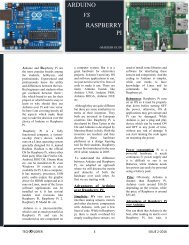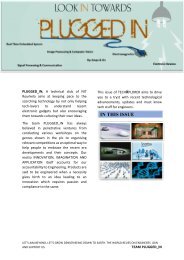7-8
You also want an ePaper? Increase the reach of your titles
YUMPU automatically turns print PDFs into web optimized ePapers that Google loves.
V2V AND V2I<br />
PENTA AKHIL<br />
Just like how phones have<br />
evolved into smartphones,<br />
perhaps cars should also take<br />
a similar route and evolve<br />
into ‘smart’ cars equipped<br />
with futuristic and practical<br />
features. Car manufacturers<br />
are seriously looking into and<br />
researching two technologies<br />
that would enable future cars<br />
to communicate with each<br />
other and with objects around<br />
them.<br />
Vehicle-to-vehicle<br />
communication (V2V<br />
communication) is the<br />
wireless transmission of<br />
data between motor vehicles.<br />
This V2V works by using<br />
wireless signals to send<br />
information back and forth<br />
between cars about their<br />
location, speed and direction.<br />
The information is then<br />
communicated to the cars<br />
around it in order to provide<br />
Information on how to keep<br />
the vehicles safe distances<br />
from each other. Imagine a car<br />
approaching an intersection as<br />
another car runs a red light.<br />
The former car driver don't<br />
see them at first, but that car<br />
gets a signal from the latter<br />
that it's directly in your path<br />
and warns the driver of the<br />
potential collision, or even<br />
hits the brakes automatically<br />
to avoid an accident<br />
V2I (vehicle to infrastructure)<br />
would allow vehicles to<br />
communicate with things like<br />
road signs<br />
or traffic<br />
signals and<br />
provide<br />
information<br />
to the vehicle<br />
about safety<br />
issues. In this,<br />
the infrastructure plays a<br />
coordination role by gathering<br />
global or local information<br />
on traffic and road conditions<br />
and then suggesting or<br />
imposing<br />
certain<br />
behaviors on<br />
a group of<br />
vehicles. In a<br />
more<br />
sophisticated<br />
scenario, the<br />
velocities and accelerations of<br />
vehicles and inter vehicle<br />
distances would be suggested<br />
by the infrastructure on the<br />
basis of traffic conditions,<br />
with the goal of optimizing<br />
overall emissions, fuel<br />
consumption, and traffic<br />
velocities. Suggestions to<br />
vehicles could be broadcast to<br />
drivers via road displays or<br />
directly to vehicles via<br />
wireless connections. V2I<br />
could also request traffic<br />
information from a traffic<br />
management system and<br />
access the best possible<br />
routes.<br />
TECHXPLORER 7 ISSUE 2-2016
Both V2V and V2I<br />
works by using<br />
wireless signals to<br />
send information<br />
back and forth<br />
between cars about<br />
their location, speed<br />
and direction over<br />
Vehicular Ad hoc<br />
NETworks<br />
(VANETs) to<br />
prevent accidents.<br />
VANET is the<br />
spontaneous creation of a<br />
wireless network for data<br />
exchange - to the domain of<br />
vehicles. Vehicular Ad Hoc<br />
Networks (VANETs) are<br />
created by applying the<br />
principles of mobile ad hoc<br />
networks (MANETs).<br />
Basically, both VANETs and<br />
MANETs are<br />
characterized by the<br />
movement and selforganization<br />
of the<br />
nodes (i.e., vehicles<br />
in case of VANETs<br />
and mobiles in case<br />
of MANETS).<br />
VANETs are<br />
characterized by<br />
rapid but somewhat<br />
predictable topology<br />
changes, with<br />
frequent fragmentation, a<br />
small effective network<br />
diameter, and redundancy hat<br />
is limited temporally and<br />
functionally.<br />
These<br />
Vehicular<br />
communications is usually<br />
developed as a part<br />
of intelligent transportation<br />
systems (ITS).These<br />
technologies could transform<br />
the way we drive and increase<br />
automotive<br />
safety<br />
dramatically. Good thing is<br />
car companies and the<br />
government are already<br />
working to try to make this a<br />
reality. All of this<br />
communication and<br />
preemptive vehicle assistance<br />
leads us into our next future<br />
technology.<br />
Even<br />
automotive<br />
manufacturers are also<br />
working on Vehicle-toeverything<br />
(V2X). It is<br />
a vehicular communication<br />
system that incorporates other<br />
more specific types of<br />
communication as V2I<br />
(Vehicle-to-Infrastructure),<br />
V2V (Vehicle-to-vehicle),<br />
V2P (Vehicle-to-Pedestrian),<br />
V2D (Vehicle-to-device) and<br />
V2G (Vehicle-to-grid). V2X<br />
is the platform that regulates<br />
all connections a car makes<br />
with the outside world, be that<br />
another car, an IoT device or<br />
even a human<br />
TECHXPLORER 7<br />
8<br />
ISSUE 2-2016





